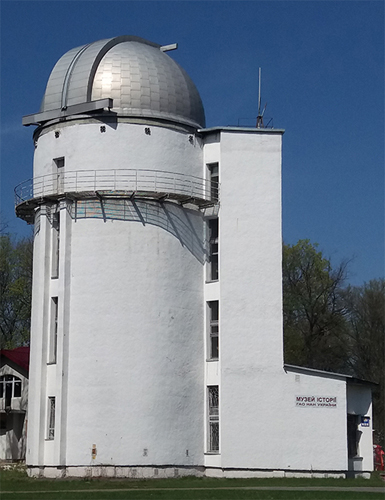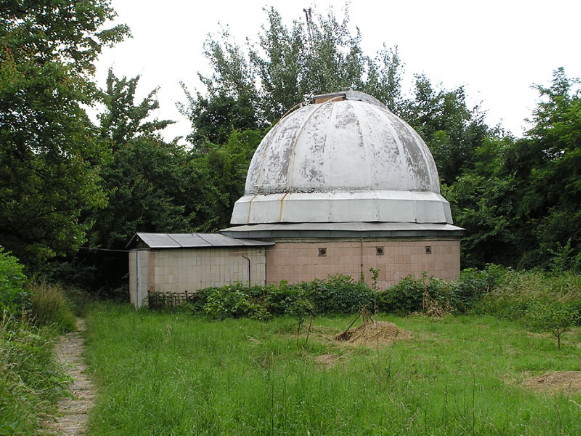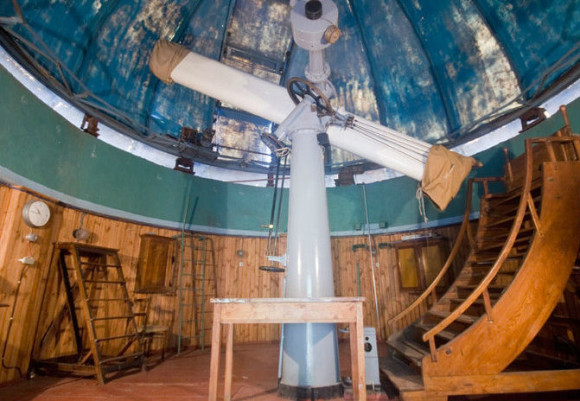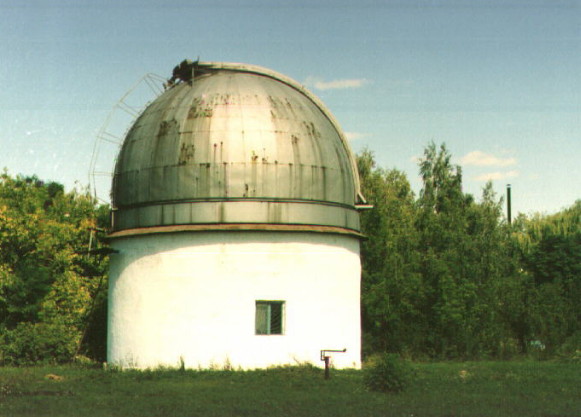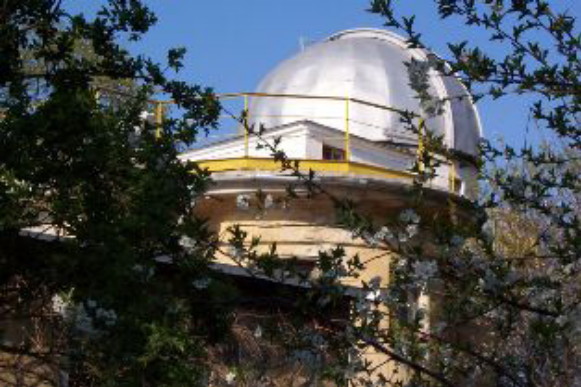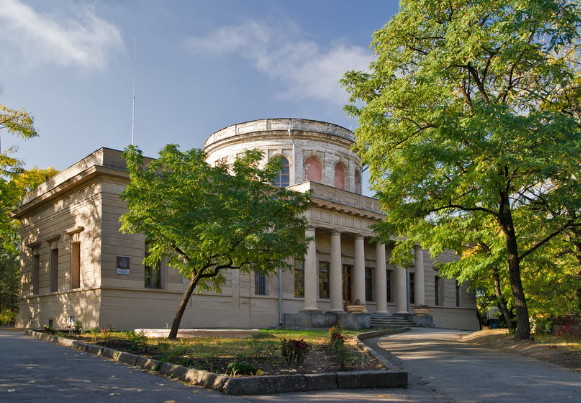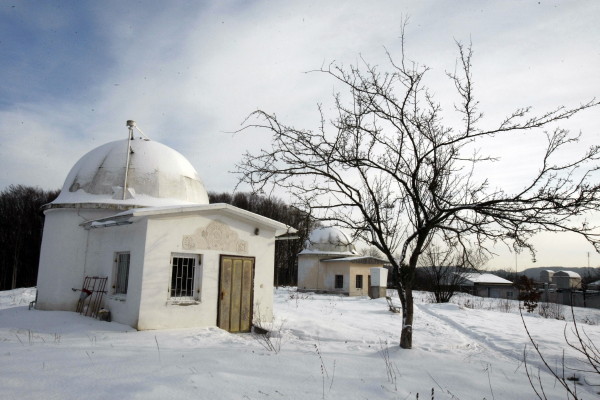Astronomy
Astronomy [астрономія; astronomiia] For several centuries cosmography—a non-mathematical and non-empirical theory based on Byzantine sources—was studied in Ukraine. A few Ukrainians who studied in Western Europe, (eg, Yurii Drohobych, a teacher of astronomy at the University of Bologna at the end of the 15th century) were acquainted with the latest theories in astronomy. At the Kyivan Mohyla Academy only the Ptolemaic theory was taught. Yepifanii Slavynetsky in the 17th century mentioned Copernicus’s theory in his Kosmohrafiia (Cosmography).
Astronomy began to develop in Ukraine only at the beginning of the 19th century and was closely tied to the construction and activity of observatories which were usually affiliated with universities. The first observatory was founded in Kharkiv at Kharkiv University in 1808 (since 1923 it has been known as the Kharkiv Astronomical Observatory). Besides investigating the planets and the sun, it specializes in astronometrics and celestial mechanics. The school of Mykola Barabashov in the field of planetary studies and particularly in the physics of the moon has a prominent place at this observatory. Among the better-known Ukrainian astronomers who worked at the Kharkiv Astronomical Observatory were B. Herasymovych, Mykola Yevdokymov, H. Levytsky, Liudvig Struve, Borys Ostashchenko-Kudriavtsev, and V. Fesenkov. The observatory published three periodicals—Publikatsiï, Trudy, and Tsyrkuliar.
A second observatory was established in 1821 in Mykolaiv. At first its purpose was to train naval officers. In 1912 it became the southern branch of the Pulkovo Observatory of the Imperial Russian Academy of Sciences and in 1926 an independent institution. Later again it was subordinated to the observatory in Pulkovo, but became an independent institution in 1991. An important contribution of the Mykolaiv Astronomical Observatory is Catalogue de 5,945 étoiles, published in Leipzig in 1900.
The observatory of Kyiv University—the Kyiv Astronomical Observatory—was founded in Kyiv in 1845. Since 1922 it has been an independent institution. Its school of theoretical astronomy, which was organized by Mytrofan Khandrykov and continued under Serhii Chorny, is widely known. Avenir Yakovkin specialized in theoretical research in the physics of the sun, stars, and interstellar space. Mykhailo Dychenko worked here. Among the better-known astronomers who did their research there are Sergei Vsekhsviatsky, Oleksander Bohorodsky, and A. Horynia. The observatory published Annaly, Pratsi, Publikatsiï, and Tsyrkuliari, and currently publishes a scholarly periodical Astronomiia.
An observatory—the Odesa Astronomical Observatory—was established at Odesa University in Odesa in 1871 to study principally the known stars and to prepare accurate catalogues (M. Tsimmerman), to photograph and observe new planets, and to study sunspots. The research on the mutating stars of type RR Lira, which was conducted by Volodymyr Tsesevych, was particularly important. At one time Oleksander Kononovych directed the observatory. M. Mykhalsky and B. Novopashenny, among others, did research at the observatory. The observatory publishes its own journals Odessa Astronomical Publications and Odesskii astronomicheskii kalendar.
At the beginning of the 20th century an observatory (astronomical institute) was set up in Lviv at Lviv University. Research on the evolution of stars and stellar photometry (E. Rybka) was begun as early as the 1930s. S. Kaplan, Vladimir Stepanov, M. Eihenson, et al conducted theoretical research here. The Lviv Astronomical Observatory’s publications were Prace, Astronomicheskii sbornik, and Tsyrkuliar.
The most important astronomical research in Ukraine is done today at three observatories: in the Crimean Astrophysical Observatory, especially the branch in Symeiz in the Crimea (founded in 1908), in Poltava (1926), and in the Main Astronomical Observatory in Holosiievo near Kyiv (1944). The Crimean Astrophysical Observatory, which used to have the largest telescope-reflector in Europe (2.6 m in diameter), organized a broad research program on solar physics. A. Severny studied the sun’s magnetic fields here. Some prominent astronomers have worked there in the past: S. Beliavsky, who discovered 37 minor planets and a comet, which was named after him, in 1911; and Hryhorii Shain, whose work on spectral analysis is continuing today.
The Poltava Gravimetric Observatory of the National Academy of Sciences of Ukraine investigates the revolution and the tidal deformation of the earth, which provides one of the key methods for unlocking the inner structure of the earth. Aleksandr Orlov initiated this work and was the main theoretician of the motion of the poles. Extending Orlov’s theories and using observations of the horizon stars at Poltava (visible daytime and nighttime), N. Popov first discovered the slight oscillation of the earth’s axis. Under the direction of Zinaida Aksenteva, the station organized research into latitude changes and the motion of the poles as well as the tidal deformation of the earth that is connected with them. Other associates of the Poltava Station continued their research at the Main Astronomical Observatory of the National Academy of Sciences of Ukraine in Holosiieve. Yevhen Fedorov, for example, worked out the nutation of the earth’s magnetic poles from 1890 to 1970 by applying his own methods of analysis to measurements of latitude made by different observatories. But the principal role of the Main Astronomical Observatory is to co-ordinate the work of all the astronomical institutions in Ukraine. Continuing the cataloguing work of the Odesa Astronomical Observatory, the Main Astronomical Observatory has prepared several very accurate catalogues; eg, a catalogue of the declination of the fundamental stars, prepared by O. Korol on the basis of 12,000 absolute observations, and a catalogue of ‘latitude stars’ by A. Kharin based on 16,000 observations by the differential method.
The research begun by Avenir Yakovkin at the Kyiv Astronomical Observatory of Kyiv University on the structure of the moon is continuing at the Main Astronomical Observatory. On the basis of Yakovkin’s theoretical speculations on the libration of the moon, A. Horynia succeeded in determining the precise inclination of the lunar axis to the ecliptic and some other constants that are very important in the theory of lunar libration. Building on the work of Mykola Barabashov in the field of planetary research, I. Koval and O. Morozhenko of the Main Astronomical Observatory determined the atmospheric pressure at the surface of Mars and speculated on the elasticity of the planet’s surface. At the observatory I. Havrylov prepared a catalogue of the selenocentric co-ordinates of 500 basistic points on the lunar surface, V. Konoplova studies the physics of comets, and I. Kolchynsky investigates the dimensions of atmospheric irregularities. The Main Astronomical Observatory The observatory publishes scientific journals Astrometriia i astrofizyka, Kinematyka i fizyka nebesnykh til, and Kosmichna nauka i tekhnolohiia.
BIBLIOGRAPHY
Barabashov, N. ‘Razvitie astronomii na Ukraine,’ Priroda, 1954, no. 8
Azarnova, T.; Shemets, N. Astronomiia na Ukraïni (1918–1962 rr.): Bibliohrafichnyi pokazhchyk (Kyiv 1965)
[This article was updated in 2016.]
